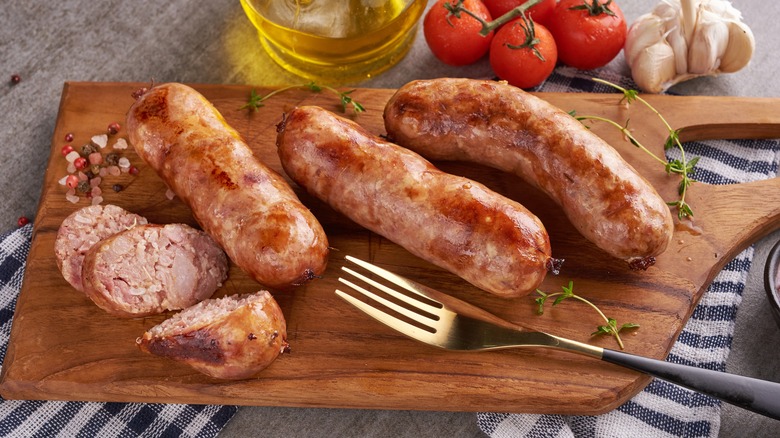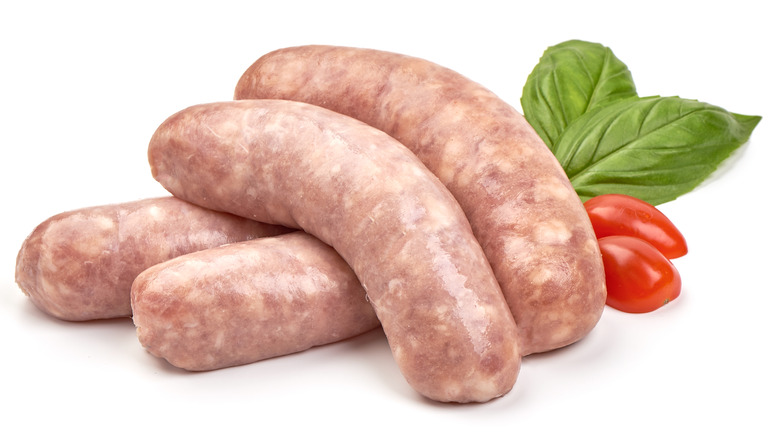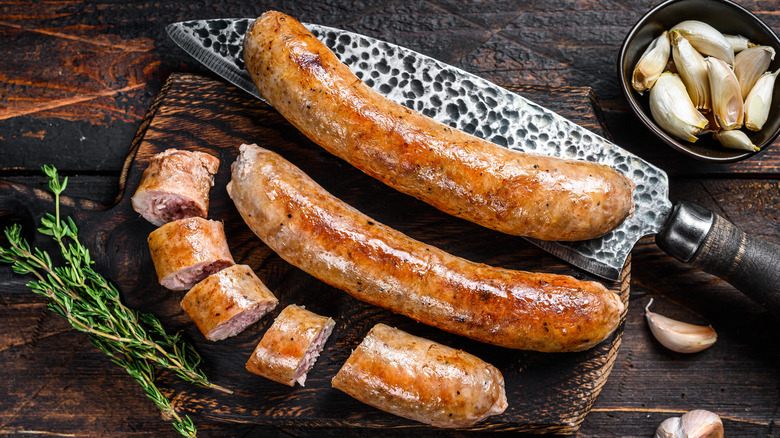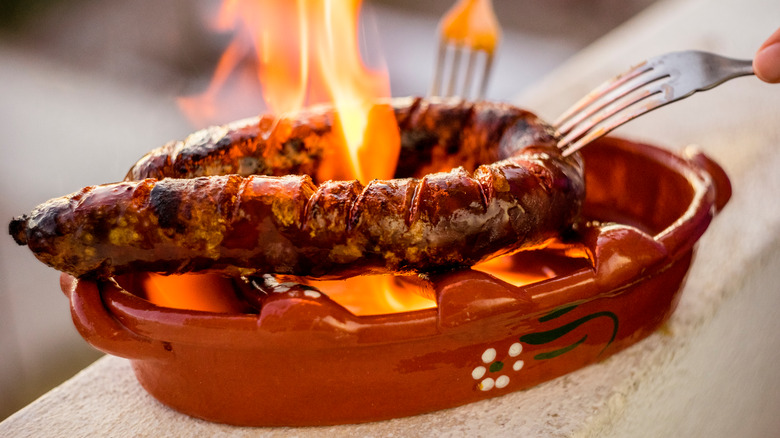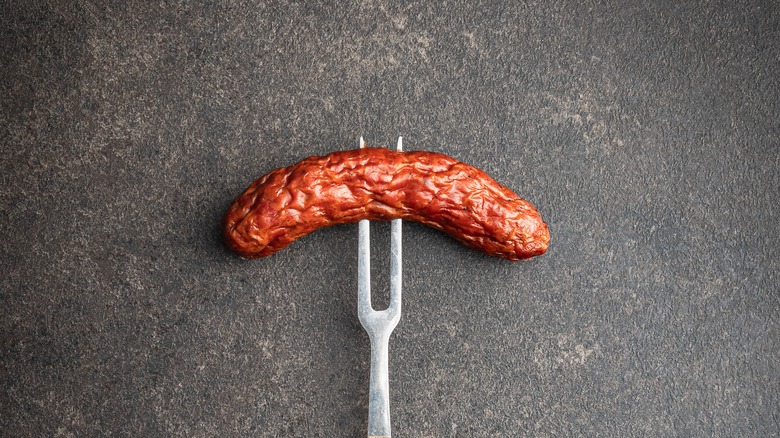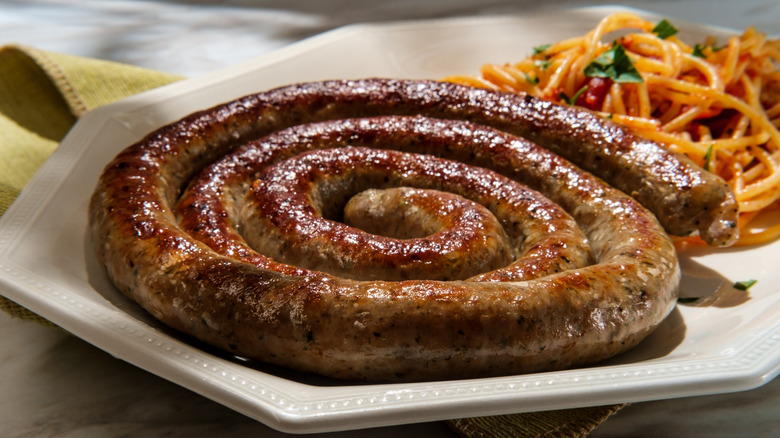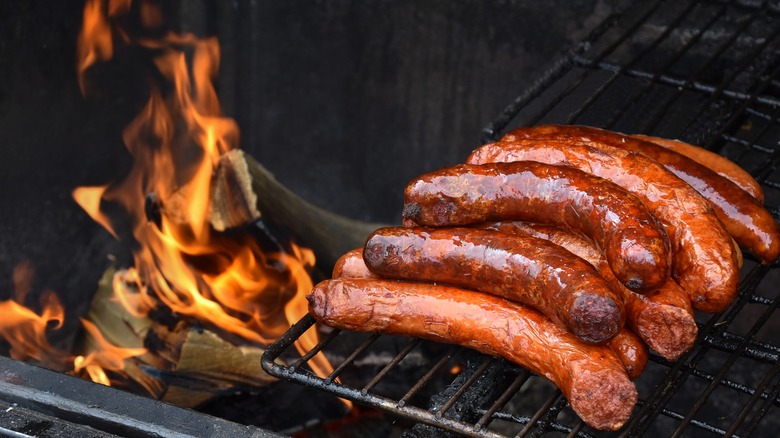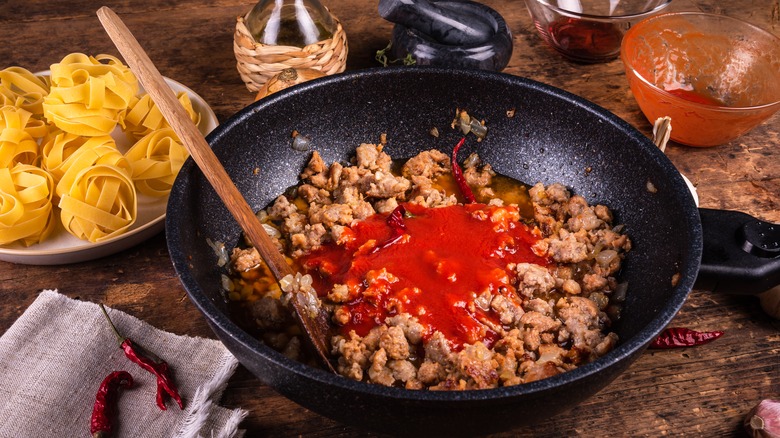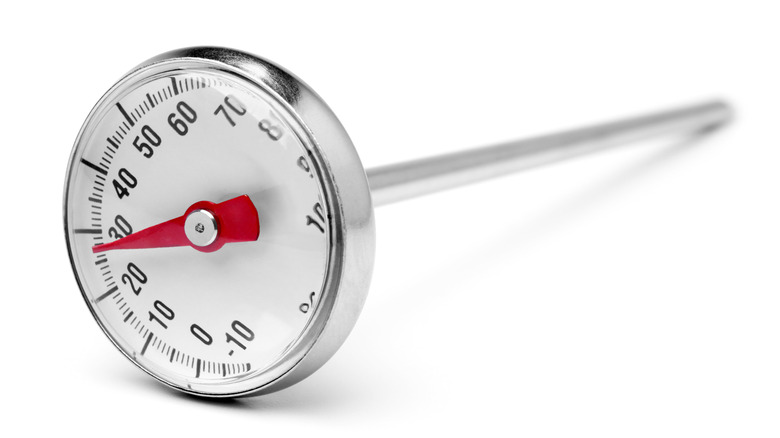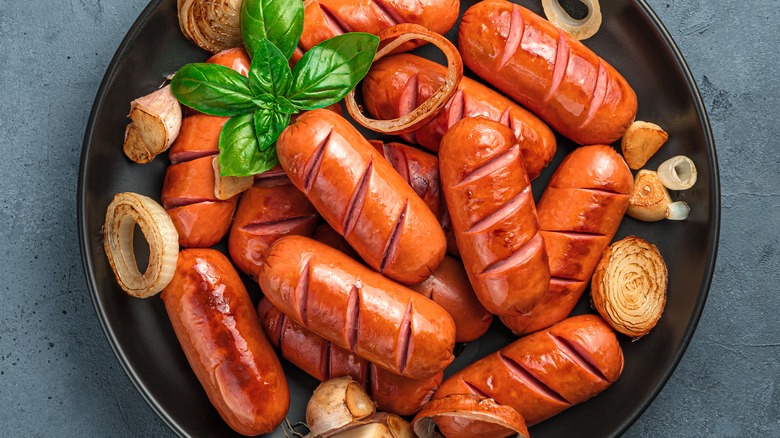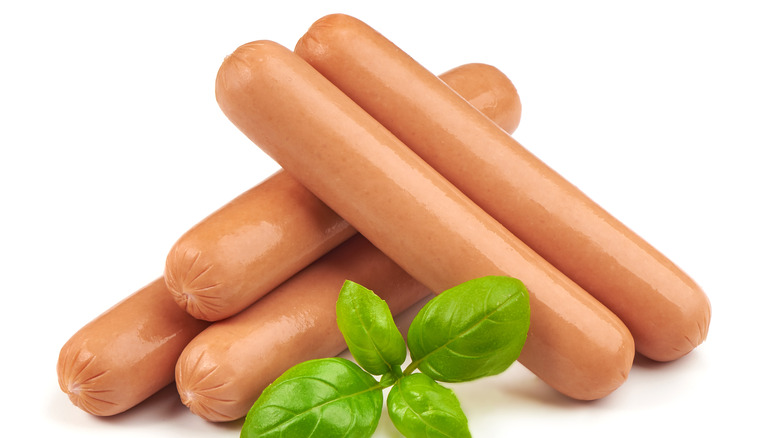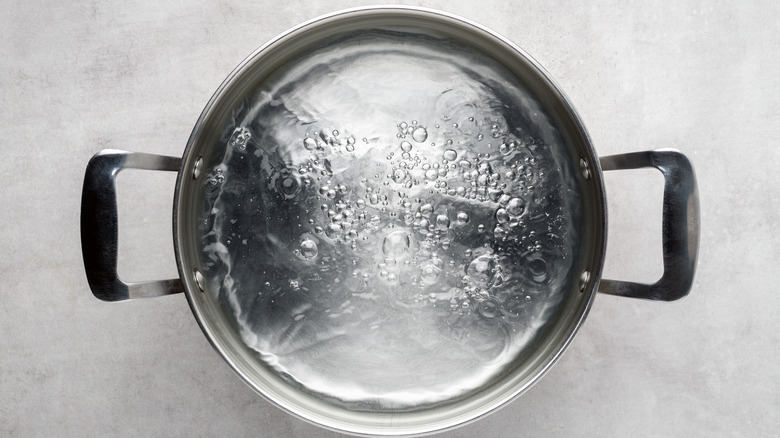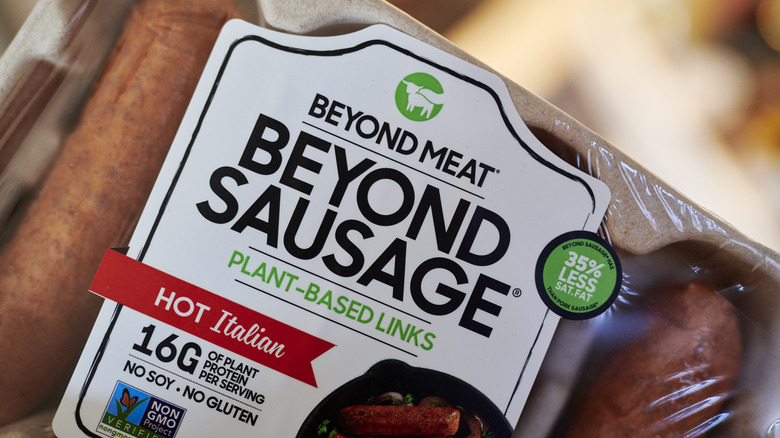Mistakes Everyone Makes With Sausage
Sausage is one of the best protein sources to build a meal around, per Livestrong. It usually comes pre-seasoned, so all you have to do is cook it, and you'll end up with a delicious piece of meat. You can buy sausages with flavor profiles that fit a wide variety of global cuisines, and different types of sausage are perfect for breakfast, lunch, or dinner.
However, just because sausage is simple and versatile doesn't mean it's foolproof. You can screw up sausage if you try hard enough. We've all had to suffer through the charred remains of an ineptly-grilled hot dog or a grisly sausage patty on a disreputable breakfast sandwich at some time in our lives. The good news is that you can avoid a sausage faux pas. As a public service, we've collected some of the most common sausage mistakes we see out in the wild. We didn't just stop at naming and shaming, either — we also included tips that will help you cook the perfect sausage every time you fire up the grill or stove.
Buying raw sausage when you need cooked (or vice versa)
There are countless types of sausage, and they're not all interchangeable with each other. Sausages are made from many different types of meat (and non-meat sources) and often come seasoned with a variety of spices. Some are sold in casings, while others come as loose ground meat.
When you're looking to make a sausage-based dish, one of the most important things to check is whether the recipe calls for cooked or raw sausage. Certain varieties, like andouille, are fully cooked when you buy them, per D'Artagnan. Others, like Italian sausage, are typically sold raw and should be thoroughly cooked before eating (via FineCooking). Pay attention to the type of sausage a recipe asks for and try to find it at your market. If you do need to make a substitution, at least try to find something with a similar flavor and texture to what the recipe says. Depending on the recipe, it may be possible to substitute cooked and raw sausage, but keep in mind that you may have to adjust the cooking time and that the taste and texture of the resulting dish may be affected by the change.
Using sausage that's too lean
We're all trying to stay in shape (especially during summer grilling season), and one way to keep the pounds off is to select lean proteins. Options like fish, chicken breast, shrimp, and tofu are all delicious and give you the protein your muscles need without a ton of extra fat. There's a good chance you'll be able to find lean sausage at your supermarket. However, while the idea seems tempting, it's best to steer clear of sausage that doesn't have a generous amount of fat.
Unlike other lean protein choices, sausage needs fat to taste good. According to Your Meat Guide, sausage should be at least 15 percent fat, and 25 percent is even better. Many sausage manufacturers make products that are around 50 percent fat (via New Zealand Casings Company). Fat is crucial for sausage because it adds flavor and prevents the meat from drying out after cooking. Fat also solidifies the sausage structure, holds ingredients together, and ensures the sausage won't become unpleasantly crumbly. Sausage is inherently an indulgence, so if you're trying to avoid fat, it's best to select a different type of meat rather than buying sausage that will become sad, dry, and tasteless on the grill.
Cooking at high temperatures
Some meats benefit from blazing-hot cooking temperatures. For example, steakhouses use super high heat (often over 1,500 Fahrenheit) to achieve the crisp and brown crust that makes premium steaks delicious. Sausage tastes great when you give it a crispy seared exterior as well. However, if you use super high heat for cooking sausages, you'll likely be disappointed when you sit down to eat.
As Quiet Waters Farm explains, high heat makes meat shrink. While this isn't an issue for some cuts of meat, bad things happen when sausage meat contracts too fast. For example, the casing might burst, or the outside of the sausage might become overcooked and leathery before the interior cooks.
Remember how important fat is for a delicious sausage? For that fat to do its job, some of it needs to stay inside the sausage after cooking. Excessive heat might melt the fat inside too quickly, making it all drip out of the sausage and leaving you with sad, dry, and lean meat. It's best to cook at low or medium-low temperatures to keep your links juicy. The outside will get crispy over time, and the inside will stay moist and delicious.
Pricking the skin
Another way to ensure you end up with dry, depressing meat instead of plump, succulent sausages is by pricking the casing before cooking. You may have grown up in a household where pricking sausages was the norm, and you'll still find people who advise using this technique today. However, it's unnecessary and makes your sausage taste worse.
Per The Guardian, people used to recommend poking holes in sausages because they were afraid the links would explode if they didn't have places for steam to vent. Modern sausages aren't bulked up with enough water for this to be a concern. Pricking is also supposed to release excess fat. However, you want to keep as much fat inside the sausages as possible. When you prick sausage casings, fat and precious moisture seep out of the filling, leaving you with slightly desiccated meat. If you're worried about your sausage splitting during the cooking process, follow the tip above and try not to cook your links in a super hot pan. If you're worried about the fat content in sausage, buy a different kind of meat.
Cutting an Italian spiral sausage before cooking
Most sausages for the grill come in individual links. Each link is a few inches long and roughly the perfect size to slide into a bun for a sausage sandwich. You might be able to find Italian sausage that is not cut into links. Known as spiral sausage or rope sausage, this type of Italian sausage is stuffed into casing and coiled into a spiral, per MEL Magazine.
While it might be tempting to cut a rope sausage into individual portions for easy maneuvering on the grill, that negates this special sausage's main advantage over links: its large size. A 2-pound sausage coil will stay juicier because it's larger than a single link. Links dry out faster and have more spots where moisture can leak out.
To cook a spiral sausage, keep it coiled tightly and grill the whole thing slowly until it's crispy and fully cooked. After it's cooked, you can slice it into individual portions without worrying about moisture loss. Follow chef Jim Mumford's advice for making the world's largest sausage sandwich: "Split a loaf of bread, toast it, garlic it and place the entire spiral in between, making one mega sausage sandwich — sharing optional."
Charring the outside
We all love a crispy, snappy, and browned sausage casing — pallid, floppy sausages aren't that appealing — but there's a difference between browned and charred. Especially on an open fire, it's easy to go over the line from brown and delicious to blackened and crunchy. Some of us may even like a little bit of that black char on our sausages, but sadly, it's not good for our health.
Cooking meat over a fire creates two types of chemicals, per SFGate. Heterocyclic amines (HCAs) form during a chemical reaction that happens whenever you cook meat at a high temperature. However, polycyclic aromatic hydrocarbons (PAHs) are unique to open-fire cooking methods. They form when fat falls out of meat and drips into the flames.
Animal testing has shown that PAHs and HCAs are both carcinogens. For this reason, it's best to steer clear of charred, blackened meat (via American Cancer Society). Fortunately, you can reduce the levels of PAHs and HCAs by cooking meat over lower heat, which happens to be the best way to cook sausage.
Not removing the casing
The sausage casing is the tube-shaped edible container that transforms blobs of ground meat and seasonings into tidy sausage links, per Premio Foods. While you can buy loose sausage (not packed into casings), most sausage is for sale in casings.
Casings are great for when you want to grill or pan-fry sausage links. However, for some recipes, you need to remove the casing. For example, in our sausage and butternut squash pasta recipe, you can clearly see from the pictures that the pork sausage links had their casings removed before they went into the pan. This step makes it easy to crumble the sausage into small pieces that are good for pasta sauce. If you tried to do that without taking the casing off, you'd have chunks of casing in your sauce, which isn't anyone's idea of good eating.
To take the casing off, cut open each link and pull out the stuffing. Sometimes, you may find that the filling sticks to the casing. To solve this issue, either partially freeze the sausage or parboil it, which should make the meat slide out easily.
Cooking to the wrong internal temperature
Sausage can be made of pretty much any kind of meat, but pork is the most common, per Il Porcellino Salumi. Sausages made with other types of meat often contain pork fat to add moisture and flavor (via New Zealand Casings Company). Pork can contain a parasite that causes the illness trichinellosis (via WebMD). Although improvements in farming practices have made this parasite much less common in the United States pork supply in recent years, other germs like E. coli, salmonella, and staphylococcus aureus are also in raw pork. For this reason, it's important to cook pork at a high enough temperature to kill any pathogens that may be present. Aim to cook pork sausage to 160 degrees Fahrenheit (via FoodSafety.gov).
While undercooking sausage is a safety hazard, overcooking it is a hazard to your tastebuds. You don't want to end up with shriveled, dry links like an unlucky poster on the Smoking Meat Forums. A meat thermometer is your friend. It will ensure you hit the safe temperature zone perfectly but don't accidentally go too far and dry out your sausages. A thermometer lets you can remove your sausages from the heat at the perfect moment.
Not letting them rest before and after cooking
If you're into cooking, you probably know that you should rest a steak after cooking it to make sure the juices don't leak out when you slice into it. You've probably also heard that you should rest your steak at room temperature before cooking to ensure that it cooks evenly and doesn't dry out on the grill. However, you might not know that this advice also applies to sausages.
Jeff Baker, a British chef, told the Daily Star that giving sausages a pre- and post-cooking rest will result in juicier, tastier links. Just like with a steak, bringing the sausages to room temperature before throwing them into the pan will allow them to cook more evenly. With sausages, this step has the added benefit of making it less likely that the casings will split from sudden heat shock. Resting the cooked sausages before serving lets the muscle fibers and juices settle, making the result juicier and softer.
Buying the cheapest sausages
Everything is getting more expensive these days. It's only natural to hunt for a bargain when buying sausages. While you can pick up links for low prices, your taste buds and stomach will thank you if you spend a few extra dollars on higher-quality meat.
The differences between expensive and cheap sausages start with the cuts of meat used, per Good Food. Low-cost sausages generally include trimmings left over from butchering premium cuts of meat. On the other hand, premium sausages often contain cuts with names you would recognize, like brisket and chuck. While eating meat trimmings isn't harmful, sausages with prime cuts usually taste better.
What's worse than trimmings in cheap sausages is all the ingredients that aren't meat. These can include water, starchy fillers, added preservatives, and flavor enhancers that make up for the bland fillers. You should know how the sausage is made to ensure it contains ingredients you want to eat. A way to know you're buying quality sausage is to actually visit a butcher rather than just picking up a shrink-wrapped package from a supermarket.
Not boiling them first
We've already mentioned that low heat is an ideal route to a juicy sausage, but if you don't want to babysit sausages in a pan as they slowly sear, there's a more foolproof method. Simmer them in liquid and then sear them, per Quiet Waters Farm.
Slowly cooking your sausages in liquid ensures they're not going to dry out. The liquid helps them cook evenly without losing juices. Even better, you can add flavor to the sausages by using something like stock or beer instead of water. You can add traditional sausage partners like sauerkraut or peppers to the braising liquid to turn them into a complete dish.
The one problem with the poaching method is that it doesn't give your sausages any browning or crust. However, you can remedy this problem. After the poaching phase, sear the sausages briefly with high heat to crisp up the casings, just like you would with sous vide rib eye steak. If you're the type of person who wants cooking to be as easy as possible, use this method.
Dismissing vegetarian sausage
The words vegetarian sausage may conjure up the image of gray, rubbery veggie dogs served as an option for vegetarians at a backyard barbecue. However, plant-based sausage technology has advanced quite a bit in recent years. It's easier than ever to find tasty meatless versions of almost any commonly-eaten sausage. Our list of vegan substitutes for sausage includes plant-based breakfast sausage, chorizo, Italian sausage, bratwurst, and more. Some mimic their meaty inspirations with eerie accuracy, while others are more obviously vegetarian. All are delicious in their own right.
Sausage is ideal for vegetarian versions because many types rely on seasoning blends for their distinctive flavors rather than the natural meat taste. Adding chorizo or Italian sausage seasoning to a vegetarian protein will remind you of the meat version. Cutting down on meat consumption is good for your health, the planet, and animals, so why not make meatless substitutions where you can? Switching to meatless breakfast sausage in the morning might be the best place to start.
